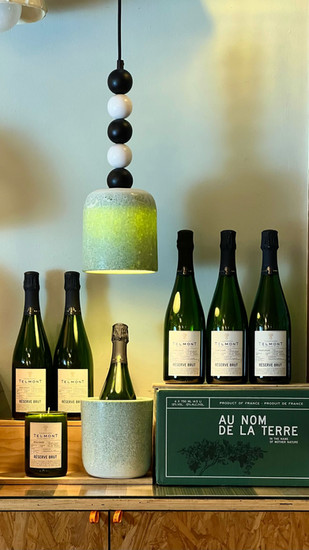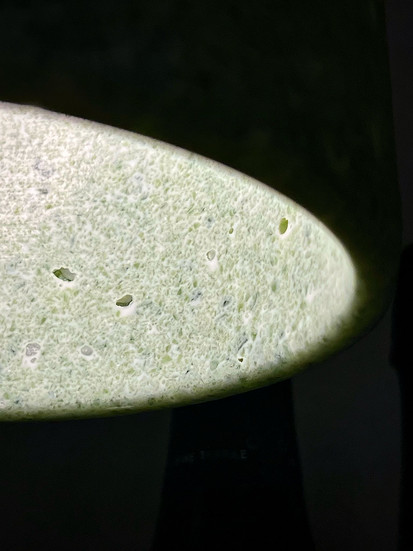The Carbon Footprint of Champagne - and a Simple Guide to Offset it
- Lucy Edwards

- Jul 2
- 6 min read
Updated: Jul 15
As champagne lovers, we’re used to nuance, whether it’s the chalky minerality of a Blanc de blancs or the fine bead in a perfectly aged vintage. But when it comes to the environmental impact of our favourite wine, nuance is often replaced with marketing gloss and vague promises. Let’s peel back the layers and look at the real carbon footprint of champagne, and what you, as a discerning drinker, can do to offset it.
The Anatomy of Champagne’s Carbon Emissions
In the early 2000s, the Champagne region was the first region to evaluate their carbon footprint on the initiative of the Comité Champagne. A bottle of champagne is a marvel of craftsmanship, but it’s also a minor marvel of carbon emissions. On average, a single bottle is responsible for 1.5 - 2 kg of CO₂. Here’s where that comes from:

1. Packaging: The Elephant in the Room
It’s not the wine itself, but the bottle that’s the biggest culprit. Over 32% of Champagne’s carbon footprint comes from packaging, specifically the glass bottle. Why? Glass production is energy-intensive, requiring temperatures above 1,400°C. Energy needed to create a 1 kilo of glass is created from 2.5kg of wood, burnt with 1 kg of charcoal and 0.2kg of fuel. And the heavier the bottle, the higher the emissions, meaning that those special bottles used for prestige cuvées can equate to over 30% more.
One of the most active houses in combatting this issue is Telmont. The house which is co-owned by Leonardo Di Caprio and Ludovic du Plessis, has made a decisive shift to 800g bottles (down from the standard 900g+). They also worked with glass producer Verallia to incorporate all hues and tints of green into their range. Normally, a house would order a specific glass colour, and Telmont has accepted that the reality of sustainability is embracing variations in hues. They shared this with the world through their 193,000 shades of green campaign last year. They’ve also eliminated gift boxes, a move that’s as practical as it is overdue.

Moussé Fils is pushing boundaries with Verallia, trialing a featherweight 722g bottle and using recyclable paper coiffes instead of traditional aluminum and plastic foils. Some producers are even omitting the foil entirely to lighted the footprint by 0.6 grams. Every gram counts.

2. Transport: The Long Road (and Sea) to Your Table
Transport accounts for around 30% of Champagne’s carbon footprint. Air freight is a carbon nightmare, but even shipping by sea or truck adds up. Enter innovation:
Mumm and Perrier Jouët recently sent 400,000 bottles to the US by sailboat. TOWT (TransOceanic Wind Transport) and Grain de Sel are providing services to houses like Telmont, Drappier, Pommery domaine de Bichery and Burgundians Joseph Drouhin who want to ship their bottles more sustainably to the US. While wind-powered shipping dramatically cuts emissions, even if it means waiting a little longer for your bottle to arrive; it represents just a fraction of bottles being shipped globally, with the majority of bottles being shipped via refrigerated "reefers".
3. Viticulture & Winemaking
The vineyard and winery together account for 15–25% of total emissions. While that’s lower than packaging and transport, it’s still significant. The best producers are moving beyond the minimum, think organic and biodynamic farming, cover cropping, and reduced chemical inputs.
Look for certifications like HVE (Haute Valeur Environnementale - ideally level 3), VDC (Viticulture Durable en Champagne), organic (BIO) or even biodynamic (Demeter). These aren’t just badges, they reflect real changes in vineyard management.
Where and hos these grapes are transformed into wine also matters;
Hostomme operates a carbon-neutral cuverie, powered by solar, rain water and geothermal energy, proving that sustainability can be built into the very walls of a winery.
Drappier is a carbon-neutral pioneer, with the transformation of their winemaking facilities almost ten years ago to be carbon neutral and hopefully carbon positive. Their set up includes solar energy, rainwater and gravity systems instead of electic pumps, in addition to offsetting emissions not just from production but also from tourism, buying carbon credits for every visitor who steps onto the estate.

4. The Rest: Construction, Water, and Ancillary Inputs
From cellar construction (hello, cement emissions) to water management and the carbon cost of storing champagne for at least 18 months before shipment (sometime in air-conditioned hangars), the remaining emissions are a patchwork of small but significant details. The devil, as always, is in the detail.
Greenwashing: Champagne’s Inconvenient Truth
Let’s address the elephant in the tasting room: greenwashing. Many houses make grand claims about sustainability, but a closer look often reveals these apply to a small fraction of their production. “Pilot projects” and “limited releases” are not systemic change. If a producer can’t tell you what percentage of their vineyards are certified, or if their sustainability report is longer on adjectives than data, be skeptical.
Transparency is the new luxury. The producers who are serious about sustainability publish hard numbers, invite third-party audits, and are open about their challenges as well as their successes.
Circular Economy: Upcycling and Beyond
Sustainability doesn’t end at the recycling bin. The new frontier is upcycling, giving champagne waste a second life:
In Singapore
Champagne Resolution Candle Co transforms empty bottles into high-end candles, extending the lifecycle of every bottle.

GXChampagne is working with Telmont to recycle bottles into light fixtures and ice buckets, proof that elegance and environmental responsibility can coexist.
Further abroad
Zeta shoes make vegan leather shoes with by-products of the wine industry. Most of the "aignes" (which includes grape residues like skins, seeds, and stalks), used to make their leather comes from Bordeaux, but there are projects to expand to respond to demand.
Research is exploring ways to repurpose byproducts like aignes, which are typically sent to distilleries, into an eco-friendly alternative to traditional insulation like fiberglass or polystyrene. This can be used for the building industry but also packaging.

How to Offset Your Champagne Carbon Footprint
If you want to enjoy champagne with a clear conscience, here’s a practical roadmap:
1. Choose Producers Who Walk the Talk
Support houses that are transparent about their sustainability efforts, Drappier, Hostomme, Telmont, and Moussé Fils are setting the pace. Look for certifications and published data, not just pretty labels.
2. Favour Lighter Bottles and Minimal Packaging
Every 100g shaved off a bottle makes a difference. And skip the gift box unless it’s upcycled or truly reusable.
3. Recycle and Repurpose
Recycle your bottles, keeping in mind that metallic foiling can not always be recycled. Check to see if the wine is using sustainable packaging (like a leaf motif on the foil on bamboo Sparflex absolute green line, or a paper foil which can be recycled in the paper bin)
Or better yet, repurpose them as vases, candle holders, or even lighting. Support brands that upcycle their own waste.
4. Carbon Capture with Trees, Soil and the Ocean
Three natural ways of capturing carbon are Trees and Soil which have a limited capacity and the Ocean which is the biggest carbon capturer. Planting trees is a classic offset, but not all trees are equal. Fast growing tree species like Maple, Oak and Catalpa help in capturing the carbon and photosynthesis eventually helps in removing them. Although, the growth of the tree may vary from location to location. On average, a tree captures approximately 21 kilograms of carbon annually. Research also states that an older tree captures more carbon and helps in removing it from the atmosphere in comparison to a new or younger tree. Plants can also exude carbon out though the roots into soil which helps in feeding the soil organisms which humidifies the carbon. Support projects that invest in biodiversity and long-term forest health, not just monoculture plantations.
Oceans are actually one of the largest sinks on the planet, absorbing roughly 25 percent of the atmospheric carbon dioxide we emit each year. The ocean tends to take up carbon dioxide through photosynthesis by plant-like organisms (phytoplankton), as well as by simple chemistry where the carbon dioxide dissolves in water. Being one of the biggest capturers of carbon, different approaches to accelerate the natural carbon cycles in the ocean are being initiated and are in its early stages. Terrestrial plants, soil and marine algae also acts as carbon sinks and remove it from the atmosphere and store carbon in them.
Although, it can only store carbon to its highest potential if the plastic waste thrown in the ocean is null. So your biggest contribution could be to switch to biodegradable products and completely cut down on single-use plastics.
5. Be a Critical Consumer
Ask questions. Demand transparency. Don’t be afraid to push back on vague claims, your purchasing power is a lever for change.
The Bottom Line: Substance Over Spin
The champagne industry is at a crossroads. Some producers are quietly transforming the way champagne is made and shipped. Others are content to let the marketing department do the heavy lifting. As a consumer, you have the power to reward those who are making real progress, and to hold the rest to a higher standard.
So next time you open a bottle, consider not just what’s in your glass, but how it got there. True luxury is knowing your celebration leaves as light a mark on the planet as possible.

Sources
https://www.terredevins.com/actualites/cop21-la-champagne-entend-reduire-son-empreinte-carbone#:~:text=Apr%C3%A8s%205%20ann%C3%A9es%20d'exp%C3%A9rimentations,un%20parc%20de%204000%20v%C3%A9hicules).
https://drinksint.com/news/fullstory.php/aid/1410/Champagne:_CIVC_unveils_lighter_bottle.html https://e360.yale.edu/features/soil_as_carbon_storehouse_new_weapon_in_climate_fight




.jpg)
































Choosing the right topic often determines the quality of an essay. An engaging theme not only captures readers’ attention but also allows deeper research and analysis. Many students seek diverse perspectives before finalizing subjects for their writing tasks. To explore more, read here about informative essay topics through MyAssignmenthelp, which can help learners refine their choices by understanding trends, research gaps, and clarity in presentation. Strong topic selection encourages logical flow and argument development in academic writing. For more insights on building analytical depth, click now to enhance comprehension and critical thinking—key elements in producing essays that reflect originality and effective communication.